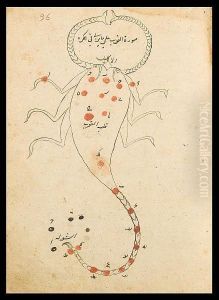Abu L Hasan Ghaffari Iii Paintings
Abu’l Hasan Ghaffari, also known as Sani' ol Molk (the third), was a prominent Persian painter born in 1814 in Iran. He was part of a well-known family of artists and became one of the most celebrated painters of the Qajar era. His uncle, Mihr 'Ali, was a famous court painter, and his brother, Mohammad Ghaffari, also known as Kamal-ol-Molk, would later become one of the most celebrated Iranian artists of the 19th century. Abu’l Hasan’s artistic journey was nurtured in this environment of creativity and excellence, which greatly influenced his future works.
Abu’l Hasan Ghaffari was initially trained by his uncle and other prominent artists of the time, which helped him develop a unique style that combined traditional Persian painting techniques with influences from European art, especially following the European travels of other Qajar court artists. His skills were recognized early on, and he was appointed as the court painter by Naser al-Din Shah Qajar, a position that allowed him to significantly influence the direction of Persian art during his lifetime.
During his tenure as court painter, Abu’l Hasan Ghaffari was responsible for numerous portraits of the Shah and other members of the royal family, as well as scenes of courtly life. His works are characterized by their intricate detail, vibrant colors, and the incorporation of European realism into Persian miniature painting traditions. One of his most significant contributions to Iranian art was his role in founding the Dar ul-Funun, the first modern university in Iran, where he also served as a professor of painting. This institution was crucial in the development of a new generation of Iranian artists and in the introduction of European artistic methods and techniques to Iran.
Abu’l Hasan Ghaffari's legacy extends beyond his paintings; he played a pivotal role in the cultural and artistic life of Iran in the 19th century. His efforts in education, his influence at the Qajar court, and his artistic innovations left a lasting impact on the development of modern Iranian art. He passed away in 1866, but his works continue to be celebrated for their beauty and historical value, marking him as a key figure in the transition of Persian art into the modern era.
